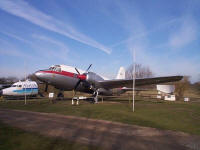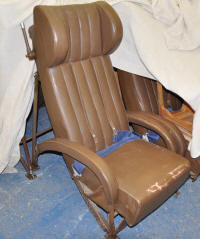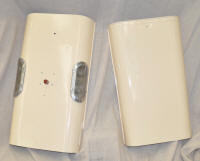Valetting the Valetta
 Our largest exhibit is the Vickers Valetta. Sadly its size
means that despite it being the only one of its type assembled
left it must be exhibited outside. The ravages of time and the
weather mean that it was getting a little damp, inside and out.
The aircraft started life as a flying classroom used to teach
students navigation. It's was then converted to the VIP
transport role before being retired and put on loan to Norfolk
Air Scouts. When the Scouts decided that they were unable to
keep the aircraft in good condition they offered the loan to us
(in agreement with the RAF Museum). It was flown from Norwich
Airport under a Chinook helicopter. Our largest exhibit is the Vickers Valetta. Sadly its size
means that despite it being the only one of its type assembled
left it must be exhibited outside. The ravages of time and the
weather mean that it was getting a little damp, inside and out.
The aircraft started life as a flying classroom used to teach
students navigation. It's was then converted to the VIP
transport role before being retired and put on loan to Norfolk
Air Scouts. When the Scouts decided that they were unable to
keep the aircraft in good condition they offered the loan to us
(in agreement with the RAF Museum). It was flown from Norwich
Airport under a Chinook helicopter.
Sitting inside the aircraft is listed as a highlight by many
of the school children who visit us to learn about World War II
(the aircraft isn't itself a WWII aircraft, but is a direct
derivative of the Vickers Wellington bomber of WWII).
 We have started a process of restoration which will hopefully
see it through another ten years before needing major attention
again. Our first step was to ensure that the aircraft was water
tight. This involved several steps, firstly re-sealing the
astrodome (this is the semi-spherical perspex dome on the top of
the aeroplane, used to take sun and star shots for navigation
purposes). The second major source of leaks was the passenger
windows, parts of these had to be replaced and other parts
re-sealed. Thirdly the cargo door was letting in water due to
changing shape over the years, it has now been returned to its
original shape. We have started a process of restoration which will hopefully
see it through another ten years before needing major attention
again. Our first step was to ensure that the aircraft was water
tight. This involved several steps, firstly re-sealing the
astrodome (this is the semi-spherical perspex dome on the top of
the aeroplane, used to take sun and star shots for navigation
purposes). The second major source of leaks was the passenger
windows, parts of these had to be replaced and other parts
re-sealed. Thirdly the cargo door was letting in water due to
changing shape over the years, it has now been returned to its
original shape.
Once water tight the process of restoring the inside could
begin. The aircraft contained two types of seat, 11 VIP seats
from its time as a transport aircraft, and four plain chairs
from the navigation training era. The VIP seats are metal and
upholstered leather, covered with plush fabric covers. The
leather has been carefully polished and mended, the covers
cleaned and the frames cleaned and made mobile again (the
reclining mechanisms had seized somewhat). The navigation chairs
and table have been stripped down and will be repainted before
being reinstalled.
 The internal cabin lining has been repaired, the wooden
batons which hold the lining in place removed and repainted. The internal cabin lining has been repaired, the wooden
batons which hold the lining in place removed and repainted.
The next steps will be to recover the cabin floor which was
red carpet, and to restore the cockpit. This will involve
cleaning up the instrument panels, and where necessary
repainting it.
We very much hope to have the aircraft open again for our
next school visits in March.
|

 Our largest exhibit is the Vickers Valetta. Sadly its size
means that despite it being the only one of its type assembled
left it must be exhibited outside. The ravages of time and the
weather mean that it was getting a little damp, inside and out.
The aircraft started life as a flying classroom used to teach
students navigation. It's was then converted to the VIP
transport role before being retired and put on loan to Norfolk
Air Scouts. When the Scouts decided that they were unable to
keep the aircraft in good condition they offered the loan to us
(in agreement with the RAF Museum). It was flown from Norwich
Airport under a Chinook helicopter.
Our largest exhibit is the Vickers Valetta. Sadly its size
means that despite it being the only one of its type assembled
left it must be exhibited outside. The ravages of time and the
weather mean that it was getting a little damp, inside and out.
The aircraft started life as a flying classroom used to teach
students navigation. It's was then converted to the VIP
transport role before being retired and put on loan to Norfolk
Air Scouts. When the Scouts decided that they were unable to
keep the aircraft in good condition they offered the loan to us
(in agreement with the RAF Museum). It was flown from Norwich
Airport under a Chinook helicopter.